 W
WThe Chaukhandi tombs form an early Islamic cemetery situated 29 km (18 mi) east of Karachi, Sindh province of Pakistan. The tombs are notable for their elaborate sandstone carvings. The tombs are similar in style to the elaborate tombs at the Makli Necropolis near Thatta, and are built in the funerary architectural style typical of lower Sindh.
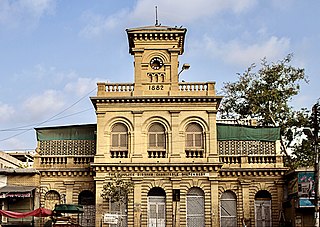 W
WEdulji Dinshaw Dispensary, officially the Eduljee Dinshaw Charitable Dispensary, is a building in the Saddar neighborhood of central Karachi, Pakistan. It was built in 1882, and served as a charitable dispensary for Karachi's citizens. It was named after Karachi-based Parsi philanthropist Seth Edulji Dinshaw, who donated 5,500 rupees towards construction - half of the building's cost. Dinshaw had risen from poverty and became the largest landowner in Karachi at the time. It was designed James Strachan, and was Karachi's first Italianate building.
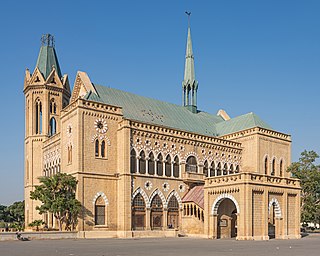 W
WFrere Hall is a building in Karachi, Pakistan that dates from the early British colonial era in Sindh. Completed in 1865, Frere Hall was originally intended to serve as Karachi's town hall, and now serves as an exhibition space and library.
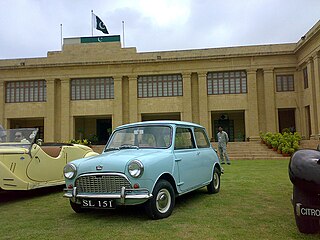 W
WThe Governor's House in Karachi, Sindh, Pakistan is the official residence of the Governor of Sindh. The current Governor of Sindh is Imran Ismail. It is located along the Aiwan-e-Sadar Road of Karachi.
 W
WHoly Trinity Cathedral is the seat of the Church of Pakistan, Diocese of Karachi, situated on Fatima Jinnah Road, near Zainab Market, in Karachi, Pakistan.
 W
WThe Jamia Mosque Khudabad known as Badshahi Mosque, is situated in Khudabad, Dadu District of Sindh the province of Pakistan. The mosque was built during the reign of Yar Muhammad Kalhoro between 1700 and 1718. It is situated in Khudabad Village almost 10 kilometres (6.2 mi) from the south of Dadu District. The mosque served as a school as well as for military training.
 W
WThe Karachi Boat Club (KBC) is a recreational boat club in Karachi, Sindh, Pakistan.
 W
WThe Karachi Chamber of Commerce and Industry Building, also known as the KCCI Building, is a heritage building in central Karachi, Pakistan dating from 1934. Its foundation stone was laid by Gandhi in July 1934. It currently serves as headquarters for the Karachi Chamber of Commerce & Industry.
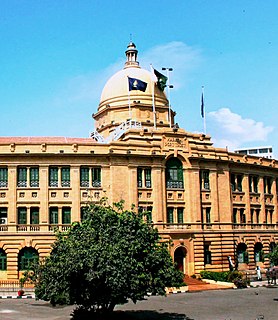 W
WThe Karachi Port Trust Building, also referred to as the KPT Building, is a large colonial-era building in Karachi, Pakistan that serves as headquarters for the Karachi Port Trust, which administers the Port of Karachi. The building dates from the height of the British Raj, and was inaugurated on 5 January 1916.
 W
WKhaliq Dina Hall, also spelled Khaliq Deena Hall, is a library and hall located in Karachi, Pakistan. The building was built in 1906, and was after Ghulam Hoosain Khalikdina - a wealthy merchant and philanthropist who was the main financier for the building, and who wished for Karachi's Muslims to have a space for literary pursuits. It currently has a hall which is used for various events, a library, and a room that serves as the office of a local NGO.
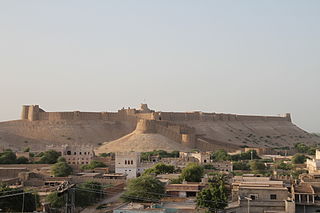 W
WThe Kot Diji Fort, formally known as Fort Ahmadabad, is an 18th-century Talpur-era fort located in the town of Kot Diji in Khairpur District, Pakistan, about 25 miles east of the Indus River at the edge of the Thar Desert. The fort sits above a pre-Harappan Civilization archaeological site dating to 2500 to 2800 B.C.E.
 W
WLakshmi Building is located in Karachi, Sindh, Pakistan. It is located at the intersection of Muhammad Ali Jinnah Road and Aiwan-e-Tijarat Road in Karachi's Mithadar district. Built in 1938, the Lakshmi Building was Karachi's tallest building at the time of Pakistan's independence and thereafter until it was surpassed in 1955 by Qamar House in the adjacent neighborhood of Kharadar.
 W
WKarachi is a tourist destination for domestic and international tourists. This is a list of tourist attractions in the city of Karachi, Sindh, Pakistan.
 W
WMakli Necropolis is one of the largest funerary sites in the world, spread over an area of 10 kilometres near the city of Thatta, in the Pakistani province of Sindh. The site houses approximately 500,000 to 1 million tombs built over the course of a 400-year period. Makli Necropolis features several large funerary monuments belonging to royalty, various Sufi saints, and esteemed scholars. The site was inscribed as a UNESCO World Heritage Site in 1981 as an "outstanding testament" to Sindhi civilization between the 14th and 18th centuries.
 W
WMazar-e-Quaid, also known as Jinnah Mausoleum or the National Mausoleum, is the final resting place of Quaid-e-Azam Muhammad Ali Jinnah, the founder of Pakistan. Designed in a 1960s modernist style, it was completed in 1971, and is an iconic symbol of Karachi as well as one of the most popular tourist sites in the city. The mausoleum complex also contains the tomb of Jinnah's sister, Māder-e Millat Fatima Jinnah, as well as those of Liaquat Ali Khan and Nurul Amin, the first and eighth Prime Ministers of Pakistan respectively. The tomb of Sardar Abdur Rab Nishtar, a stalwart of the Muslim League from Peshawar, is also located there.
 W
WMerewether Clock Tower or Merewether Tower is a neo-Gothic clocktower built during the Victorian era in Karachi, Pakistan. The tower is a landmark in central Karachi, and is at the termini of two of the most important roads in central Karachi: Muhammad Ali Jinnah Road and I. I. Chundrigar Road. The tower used to mark the boundary of the city when arriving from the port at Kiamari, and marked the dividing line between Karachi's Old Town and its newer European quarters to the east. It currently is the westernmost point of the Serai Quarter.
 W
WThe Mohatta Palace is a museum located in Karachi, Sindh, Pakistan. Designed by Agha Ahmed Hussain, the palace was built in 1927 in the posh seaside locale of Clifton as the summer home of Shivratan Mohatta, a Hindu Marwari businessman from what is now the modern-day Indian state of Rajasthan. The palace was built in the tradition of stone palaces of Rajasthan, using pink Jodhpur stone in combination with the local yellow stone from nearby Gizri. Mohatta could enjoy this building for only about two decades before the partition of India, after which he left Karachi for the new state of India.
 W
WThe Mukhi House also known as Mukhi Mahal is a heritage home located in Hyderabad, Sindh, Pakistan. It was built in 1920 by Jethanadas Mukhi. The Mukhi House is opened for the public as an archaeological museum after restoration of the building's disfigured glory.
 W
WNaukot Fort is a fortification that was established by Mir Karam Ali Khan Talpur in 1814. It is situated in Mithi Taluka, Tharparkar District, approximately 64 km in the south of Mirpur Khas town, Sindh. Its location gave it its other common name, "The Gateway to the Thar Desert". It is meant to guard the area against the Rajputs.
 W
WPakka Qilla, formally known as Pakka Qilla, is a fort in Hyderabad, Sindh, Pakistan.
 W
WPamwal Das Shiv Mandir at Pawaldass compound at Kakri Ground in Baghdadi area of Lyari Town. According to the Human Rights Commission of Pakistan and The News International Muslim clerics have illegally turned this centuries-old historic temple into a Muslim pir and slaughterhouse for cows with the help of Baghdadi police after making series of attacks on Hindu families living in the area.
 W
WThe Quaid-e-Azam House, also known as Flagstaff House, is a museum dedicated to the personal life of Muhammad Ali Jinnah, the founder of Pakistan. Located in Karachi, Sindh, Pakistan, it was designed by British architect Moses Somake.
 W
WThe Rama Pir Mandir is a Hindu temple dedicated to Ramdev Pir in Tando Allahyar in Sindh, Pakistan. The annual Ramapir Mela festival is the second largest Hindu pilgrimage in Pakistan, after the annual Hinglaj yatra which is the largest Hindu pilgrimage in Pakistan
 W
WRanikot Fort is a historical Talpur fort near Sann, Jamshoro District, Sindh, Pakistan. Ranikot Fort is also known as The Great Wall of Sindh and is believed to be the world's largest fort, with a circumference of approximately 32 kilometres (20 mi). The fort's ramparts have been compared to the Great Wall of China.
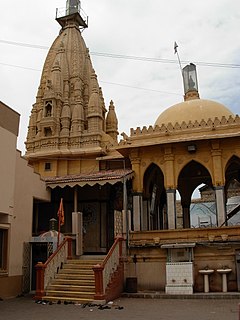 W
WThe Shri Swaminarayan Mandir, Karachi is a Hindu temple that is the only Swaminarayan temple in Pakistan. The temple is notable for its size and frontage, over 32,306 square yards (27,012 m2) on the M. A. Jinnah Road in Karachi city. The temple celebrated its anniversary of 216 years in April 2004. It is believed that not only Hindus but also adherents of Islam visit the temple, which adds to its notability. There is a sacred cowshed within the premises of this temple. The temple is located at the centre of a Hindu neighbourhood in Karachi. The building that housed a dharmshala for visiting devotees has now been converted to the office of the City District Government.
 W
WThe Shrine at Odero Lal ,also spelt Udero Lal, is a joint Muslim-Hindu shrine located in the village of Odero Lal, near the city of Tando Adam Khan in the Pakistani province of Sindh. The shrine is notable as it is jointly used for worship by members of both faiths, while both communities also display reverence for the nearby Indus River at the shrine.
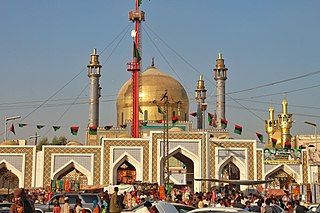 W
WThe Shrine of Lal Shabaz Qalandar is a shrine dedicated to the 13th century Muslim and Sufi saint, Lal Shahbaz Qalandar. The shrine is located in Sehwan Sharif, in the Pakistani province of Sindh. The shrine is one of the most important in Pakistan, and attracts up to one million visitors annually.
 W
WThe Shrine of Shah Abdul Latif Bhittai is an 18th-century Sufi shrine located in the town of Bhit Shah, in the Pakistani province of Sindh. The shrine is considered to be one of the most important in Sindh, and its annual urs festival attracts up to 500,000 visitors.
 W
WThe TDF Ghar is an informal learning space situated in Karachi, Pakistan. It’s a house constructed in the 1930s and restored as a living museum. The Dawood Foundation (TDF) has retained the heritage architectural features of the house to preserve the living style of the past residents of cosmopolitan Karachi.
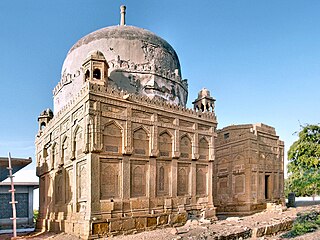 W
WTomb of Tharo Khan is the tomb of Tharo Khan Talpur, located in Mirpur Khas, in Sindh, Pakistan. The tomb is related to the Tombs of Talpur Mirs complex, built in the eighteenth century in the city of Hyderabad. The tombs are of the ruling Talpur Mirs of Sindh.
 W
WThe Tombs of Talpur Mirs are a complex of tombs of the ruling Talpur Mirs of Sindh who reigned from 1784 to 1843. The tombs are also known as Cubbas. These tombs are located in Hirabad, Hyderabad in the Sindh province of Pakistan.
 W
WUmarkot Shiv Mandir is a Hindu temple situated in Umerkot District, near Rana Jaageer Goth, in Sindh Province of Pakistan.This temple is perhaps the oldest in Sindh.The temple is one of the most sacred Hindu place of worship in the Sindh
 W
WWazir Mansion known officially as Quaid-i-Azam Birthplace Museum is a former family home in the Kharadar district of Karachi, Sindh, Pakistan which is considered the birthplace of the country's founder, Muhammad Ali Jinnah.